Now, in 2015, the girl is no longer Moullet’s gun, but both monster and victim ― the subject and object of fear and violence alike, she is villain as much as she’s Final Girl. Ask any men’s rights activist, and you’ll hear that she lurks beneath his bed more often than she’s found inside it. If there has been some essential sea-change in the treatment of woman, therefore, it has been in her reinvention as the sometime-cryptid whose sex is a poison-intoxicant. In the eyes of her detractors, the modern girl is a honey-trap host for some unknown evil parasite; a predatory beast, both foxy and foxily-cunning in equal measure, a militant, and the eventual catalyst for man’s downfall ― cruelly denying him sex in exchange for his friendship, and tearing to pieces his gossamer feelings. She is an alluring Chupacabra ― the girl next door, absolutely, but one who lives in the dank of the crawl-space, instead of the house.
Happily, monsterhood as a state can be aspirational: adaptation, in some special cases, equips the oppressed and embattled creature with larger jaws. “The figure of the future,” says Derrida, “[is] that which can only be surprising, that for which we are not prepared, you see, is heralded by species of monsters. A future that would not be monstrous would not be a future; it would already be predictable, calculable, and programmable tomorrow.” In A Girl Walks Home Alone At Night ― a film whose very title is a micro horror-story in the mode of that Hemingway bit about baby shoes ― the titular girl is a vampire set in this same futuristic mould, whose victims are men. She is a “woman in the shape of a monster” and a “monster in the shape of a woman,” as in the poem by Adrienne Rich, and such modern boogeywomen are a necessarily-updated myth for this age of Mad Max multiplex feminism. Watching Ana Lily Armirpour’s girl-beast antihero in action, I found myself thinking again and again of the similarly-inhuman ‘female’ protagonist of Jonathan Glazer’s Under The Skin, who also uses her ersatz womanhood as bait, and who likewise is dedicated to the act of harvesting eau du male from an unsuspecting masculine public. The motivations of Glazer’s sex-doll extraterrestrial are somewhat more opaque, but the principles in play are more or less the same: the two are milk-sisters even as they are wildly different characters, following the historical precedent that even monsters have mothers, and that in movies, those mothers mate as mantises do. Compare them more directly, and we might conclude that one of them is a vampire, and the other a vamp ― a fact which might suggest a greater distinction if the two terms didn’t carry the same approximate meaning, our modern use of the latter being taken from a Rudyard Kipling poem with the former’s title ― and that they approximate, together, the duplicitous, pushme-pullyou nature of the demon-feminist villainess. Both of them also go nameless, though they are given cipherish reference titles in each film’s promotional literature; Sheila Vand is billed as “The Girl,” and Scarlett Johansson “The Female,” their collective anonymnity being best contextualised by a passage from Dorothy Parker’s The Waltz:
“He scarcely knows my name, let alone what it stands for. It stands for Despair, Bewilderment, Futility, Degradation, and Premeditated Murder, but little does he wot.”
Like Dorothy’s foolish suitor, the men in both films are depicted as being clueless and bewildered; endangered by their ignorance ― little do they wot as they stagger tipsily into the hell-mouth, dicks in hand. To see both Amirpour and Glazer’s girlmonsters in action is to wonder how much their victims understand about mortal, terrestrial women in the first place, though perhaps the most obvious disparity between these ghoulettes is the way that they bait their traps. Had Johansson’s character been played instead by, say, a surgery-perfected Megan Fox, or an otherworldly Angelina Jolie ― any, really, of that special breed of Hollywood starlets whose angular, golden-ratio perfection is suggestive of an alien nature in paparazzi shots alone; whose combination of genetics and well-invested money have rendered them somehow a different race from us altogether ― I suspect that Under The Skin would have had a more exploitative air. As it stands, the actress’ beauty in the film is more like that of a smalltown stripper, or the most desired graduate of any given sixth-form or high school. Her shortness and softness are almost alarming in the context of a big-screen production, and any woman of similar stature knows that she carries the stink of a victim ― will also admit, if pressed, that she also carries her car-keys between her knuckles, or a pink rape-whistle on a keychain, or an air of perpetual readiness (I should know: I am one of them). Where one might expect a predator to dazzle with its approach, it is the banality of her speech which proves hypnotic.

“So, do you shop at night, then?” “Why are you here?” ― as a huntsman spider is indistinguishable from the loam it hides in, so a cannibalistic alien cloaks itself in the guise of a woman who is naïve or stupid, or a hidden-camera porno actress, or some curious combination of the three. Johansson’s alien girl is a shuttered-off playground littered with land-mines; a fair whose cotton-candy machine is filled with strychnine, or, I suppose, a vagina with teeth. Her giggle is effectively the imitation-lure of a margay. A Girl Walks Home Alone At Night and its own Girl, by contrast, are ‘cool’ in both of the more immediate senses ― the film is as knowingly hip as it is atmospherically glacial, with a monster-girl at its centre who is icier and more controlled. Unlike The Female, she is almost entirely sexless, even when briefly appearing naked; she smears her pillar-box lipstick as broadly as if she had never before seen a human mouth, and dances as if she is being electrocuted. Most of all, she is not in the business of catching flies with honey-voiced small-talk, knowing that silence, stock-still stealth and the teeth of a jungle cat will inevitably function better in its place. She does not care whether you shop at night, or why you are here, or whether or not you might think she is pretty. While men approach Johannssen’s otherworldy seductress with their jutting hard-ons exposed like weapons, a scene in which Sheila Vand’s Girl is cooly observing an iron-pumping pimp ― the world ‘SEX’ tattooed around his jugular ― reads as nothing less than profoundly emasculating: as conducive to an erection as an overdose of cocaine. In fictional terms, A Girl… is a story whose action takes place in Iran, though the picture was actually filmed in Bakersfield U.S.A. ― a sizeable city near the San Joaquin Valley whose mother State, California, represents a different but equally-distinctive circle of Hell: one where the ultimate sin is ugliness.

"I…don’t like old,” Amirpour raved while promoting the film. “ I don’t care how many fuckin’ Ansel Adams photos you take of old people and try to tell me it’s beautiful. It smells bad and shit’s failing. You’re rotting inside yourself, inside your own body.” Translated to Latin, this might yet achieve popularity as the crest-motto of California — it might be put to effective use as a guideline for living as a deathless bloodsucker, or for contemporary film-making, or to rail against the act of being forced to live in the decomposing body of a girl. In retrospect, it is easy to imagine this particular dictatorial bias having led to the wild discordance in outlook that springs up, like a Magic Eye illusion, after looking for long enough at the two films. Vampirism is, in theory, a thoroughly effective means for avoiding the most humiliating effects of old-age on the human body, but it also negates the need for the other more desirable human traits, like emotional intelligence. Though Glazer’s sci-fi horror might as easily have taken the name A Girl Drives Home Alone At Night (though where ― and what ― was home, exactly, for its predator-girl remains unclear), the switch is absolutely non-reversible. For a film so fascinated with the drawing of blood, A Girl… is eerily bloodless. There’s no grand realisation of what adopting the outward appearance of womanhood might mean for The Girl, the way that there is for The Female, and no comeuppance, either. Her escape — with its tacked-on stab at romance — is a wash, where the stripping of her alien sister’s human skin by a rapist feels infinitely poignant. Piercing a vampire’s ear with a diamond makes an arresting image, yes: not one, though, which can touch the tender, enduring horror of Scarlett Johanssen’s panic, examining herself in the filthy glass of a bedroom mirror and understanding —finally, violently and helplessly — the real implications of the wound between her legs.
Philippa Snow is the editor of Hexus Journal


